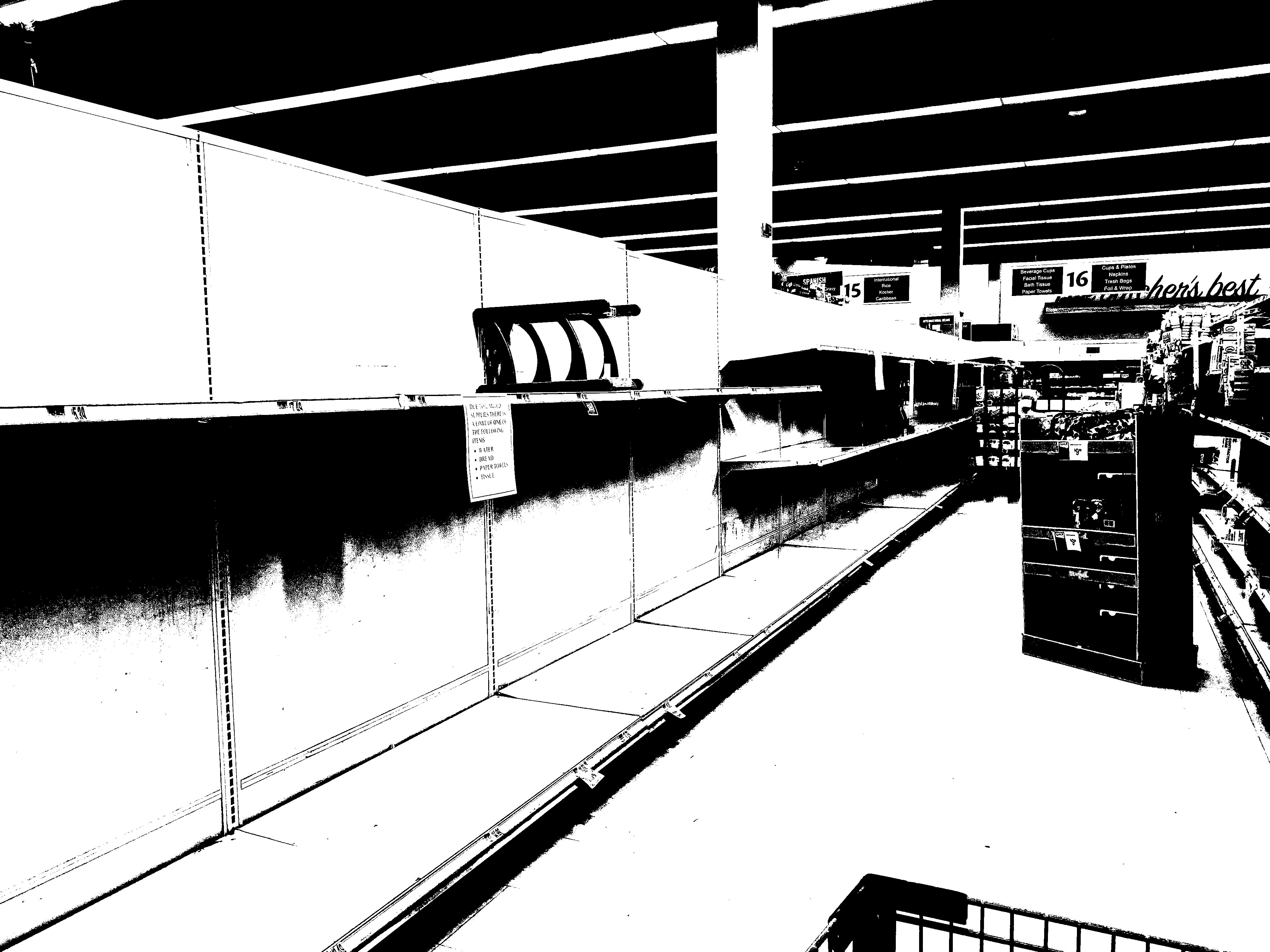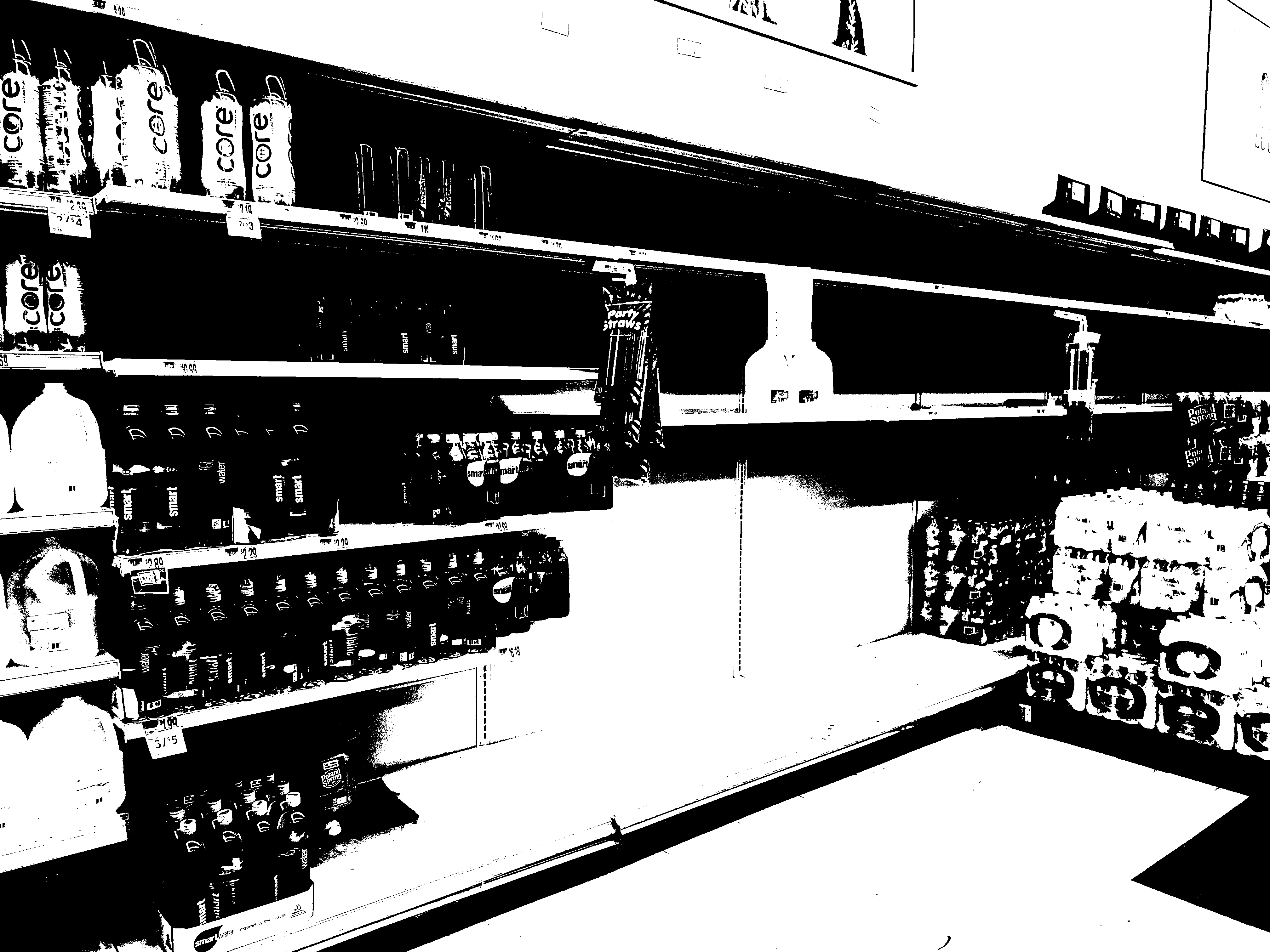In light of the current moment of crisis, this piece offers a brief coda to my article, “Techniques of Assembly,” which was published in the recent “Techniques and Technologies” issue of Amodern.
Our supply chains groan, creak, and—potentially, eventually—snap under the weight of the current crisis. They are victims of a seemingly sudden sickness. The earliest symptoms were evident in the most critical objects of the global epidemic: masks, sanitizer, and other prophylactic protections. Offered to combat the spread of that other, more pressing, disease, they moved unexpectedly from professional practice to hypochondriac hands, twisting the prior pathways of their supply beyond recognition. But this is a systemic illness. As global movements reverse course across the vast reaches of logistical space, everyday items like paper towels, toilet paper, water, and cleaning products are visible only in their absence. Fruits and vegetables, milk and meat—even the grain to feed the animals that provide them—all seem set to unravel. But when these chains—sick and weakened—stumble and fall, the result is not just the empty space on store shelves. In this breakdown we find an entirely unfamiliar state. The supply chain is an act of assembly, but now—it seems—is time for something else. This is a time of disassembly.

Over the past several decades the state of the world’s production has been lean. The necessity of this regimen was a story told in corporate boardrooms, as old titans of industry looked out on Asian Tigers made powerful by the hunger of newly global opportunity. To become lean companies cut costs by reducing stockpiles, running operations on “outsourcing and thin margins” as they worked (other) hands to the bone in an effort to minimize the time products spend at each stage of their preparation. But now the storehouse is empty and the years of plenty are at an end. Without the resilience of reserves, any further reduction serves only to magnify the impact of even the smallest disruption to the world’s assembly. When a “component can’t be built because the workers are locked down” or it “can’t be shipped as fast because of travel restrictions,” we discover that the chain has been tied too taut to compensate for the calamity of the present condition. The lean of disease, after all, is of wasting. It is pestilence and famine come together. Deliveries slow and shelves empty, the great global reserves of cheap labor still—at least partially—numb as the system reels from a shock of supply to one of demand.
We live in the time of a particular kind of production. Recognizing inventory as the enemy of profit, of the lean efficiency of exchange, we have made to make the materials of the world assemble just-in-time. But, one must ask, in whose time? Whose time is this? It is certainly not the time for factories—with their labor still weakened from an extended holiday that brought with it little joy. Efficiency has made to order a system too fragile to compensate for such a moment of crisis. Grains of sand have fallen in the tightly wound mechanisms of global production, and it has slowed to a stop. But neither is it the time for the more proximal sites of assembly. Restaurants are closed, shops are shuttered. Those that remain have focused their supply with narrow precision. It is not the time for consumers, because it is not a time to consume. One can only subsist. The packages that move through the warehouses and way stations of the great global supply chain have slipped in their careful choreography. They bring with them only the disconcerting discovery that what few goods they carry are not, themselves, so timely. They are the already-assembled. In this, they offer a meager reserve for our lean time. As capital moves quickly to consume itself, the wasting hunger of shifting demand, anemic supply, and a sickening network becomes ever more pronounced—even as it argues that the cure will surely be worse than the disease.
Digital supply chains have been made out as a promised panacea for this new time of disassembly—a cure-all for the virulent vectors of the physical supply chain. But such a transplantation risks rejection. Services rush prerecorded products into the digital pipeline to meet an insatiable demand for connection. Too often these actions drip with desperation, resembling nothing so much as a mobile phone masque. Calls to “scale up” technologies like telemedicine and remote learning rely on embracing an infrastructure of care that is too absent for too many. Distant doctors can look at bumps and bruises, but they cannot take temperatures or administer injections. While we may take some comfort in the fact that no viruses, only videos, travel these lengths, they are nonetheless a poor substitute for food, water, and the warmth of human affection. Nor are they immune from the systemic symptoms of disease. Even now our digital chains become more unsure and unsteady—rationed like any other resource. Streams that been smooth buffer again, sluggishly switching between blocks of varyingly precise pixels.

Even if the connections afforded by digital supply chains aren’t entirely ineffective, they nonetheless function primarily as alternative interfaces to more conventional points of supply—and in this regard risk the same bracing breach of contact. After all, Uber Eats may bring food to your door, but it does not quell the fear of human contact with carrier and container. “Platform delivery systems are keeping the stressed social fabric intact,” Ben Bratton explains, enabling a kind of “private encapsulation” that leaves us “shopping on their phones and eating what the person + food factory at the end of the app brings to the door.”1 But in doing so the crisis has squeezed the pathways of distribution at both ends of the gig economy, heightening the precarity of our already precarious piece-work provisioning. In response, companies like Amazon and Walmart (or Dominoes and 7-Eleven) have gone on (presumably temporary) hiring sprees to meet the rapidly rising demand of the shifting market—as have grocery delivery companies like Instacart. More parasitic services like Uber Eats, Seamless, and DoorDash—with less-profitable prospects—have dropped delivery charges or introduced promotions intended as logistical life-support for host industries now in critical condition. Uber and Lyft have suspended shared rides in the name of social distancing, even as their workers struggle with the economic impact of an “encapsulated” public. These impacts have rippled through the conventional economy. For some, the gears have halted—or will stop soon. Elsewhere the forces of production have been mobilized in the “war” against an invisible enemy. While not every supplier has been able to marshal their forces to the cause, many have shifted their operations to the manufacture of masks and other life-saving equipment. If we are still assembling, it is in these new and unfamiliar configurations.
In this regard, we must recognize that every time of disassembly carries with it the possibility of re-assembly—for the coming together of something new. At the top of the supply chain companies like Amazon use this opportunity to assemble an enormous power, acting as if they are temporarily inoculated against the kinds of criticisms that had only recently afflicted them. Like other governments, they too have deemed some services “non-essential,” a public health policy that serves to re-crystalize their control over the logistical infrastructure of the crisis. Though Amazon claims to be “prioritizing household staples, medical supplies and other high-demand products,” these provisions target primarily what other sellers and vendors ship to the company’s warehouses. Kindles and Echos still seem in sure supply, though even Amazon’s reserves are not limitless.
Still, sales surge along with the workforce. Not only masks and videogames, humans too are packed into packages—into the confining constraints of Amazon’s warehouses and fulfillment centers. They work until they can no longer. Fear of infection looms over them. Any disruption to their ability to deliver goods, we are told, could affect the “countless customers” who have turned to the company in order to escape the risk of having to “venture out to physical retailers and potentially spread the virus.” Delivery drivers have been drafted in an analogous fashion, working in extreme conditions to recover—still unsuccessfully—something of the pace and pattern we had come to associate with logistical time. In this slipshod assembly the constraints of mobility and efficiency have shifted.
If the disinfected air of warehouses and delivery trucks remains beyond our consumptive imagination, this—this slippage of time—does not. Not two-day delivery, but three. Not days, but weeks (if at all). Orders are quarantined. The smooth surface of logistical space is split along its fault-lines, fractures and fissures evident at every part of the process. Infrastructures become visible only when they break down, when the baseness of their materiality returns to us.2 If the current moment has produced anything it is this—a shocking awareness of the true state of things. We see clearly now the fragile logistics of modern life, supply bound up in only paper chains.
“This is a war…and in war, strategy is important.” But so too is logistics. And though it is the “science of detail,” the logistical infrastructure of modernity is ill-equipped to manage the simultaneously massive and minute transformations that have followed from this series of rapid changes to global material life. Even localized disasters—hurricanes, floods, and tsunamis—have, after all, had profound impacts on the production and distribution pathways of global supply chains. A worldwide work stoppage is not something that even the most “resilient” model of modern assembly—one founded on, as Anna Tsing has put it, arrangements of subcontracting, outsourcing, and a new mobility of labor—can account for.3 Time is critical, and there is no just no time to adapt to these conditions. Capital finds itself—for the moment—deprived of geographies to colonize and a workforce to exploit.
In this interregnum, there are calls for an increased understanding of the supply chain, for an improvement in our so-called “logistical literacy.” This carries with it a (presumably hopeful) reminder that the supply chain is “not a chain,” but a “network.” As a network, we can speak of fault tolerances and redundancies, connection and reconnection. This crisis becomes temporary—a momentary disruption, awaiting only a router reset. But why? We have seen these flows erode the value of labor and life, washing over the vulnerable and flooding our future. Even taken as a network, the state of supply is patchy and piecemeal. It is (and has always been) reliant on precarious points of connection, where human eyes must inspect goods, human hands must load trucks, and human drivers must still drive them. In China, one part of the network becomes reconnected (though “at a slower pace than anticipated”), as Foxconn factory workers return to the business of assembling iPhones. In Europe and North America, the other falls apart—without enough delivery drivers to distribute, or enough consumers left with the ability to consume. The supply chain has never seemed more broken, the network never so fragmented. And so, we must ask: why do we want to reforge these chains? What time is it, after all? Is it time for the largest logistical operators to consolidate their power, as the contingent actors of connection sicken and die? Or is it time for a new kind of assembly? One of the most surprising outcomes of the current moment is the way it has revealed what was already present, the power of the always-essential worker finally recognized as such. As Ingrid Burrington and Mary Jirmanus Saba have noted, “Amazon workers are realizing their own power at a moment when Amazon’s influence on the economy has never been larger.” In a time for disassembly, new configurations become possible. Perhaps in one of these configurations, the time for supply chain capitalism is coming to an end—just in time for a new sort of assembly to be formed.

References
-
Benjamin H. Bratton, “18 Lessons of Quaratine Urbanism,” Strelka Mag (March 2020). ↩
-
Susan Leigh Star and Karen Ruhleder, “Steps Toward an Ecology of Infrastructure: Design and Access for Large Information Spaces” Information Systems Research 7, no. 1 (Spring 1996): 113. ↩
-
Anna Tsing, “Supply Chains and the Human Condition,” Rethinking Marxism: A Journal of Economics, Culture & Society 21, no. 2 (Spring 2009): 148-176. ↩


